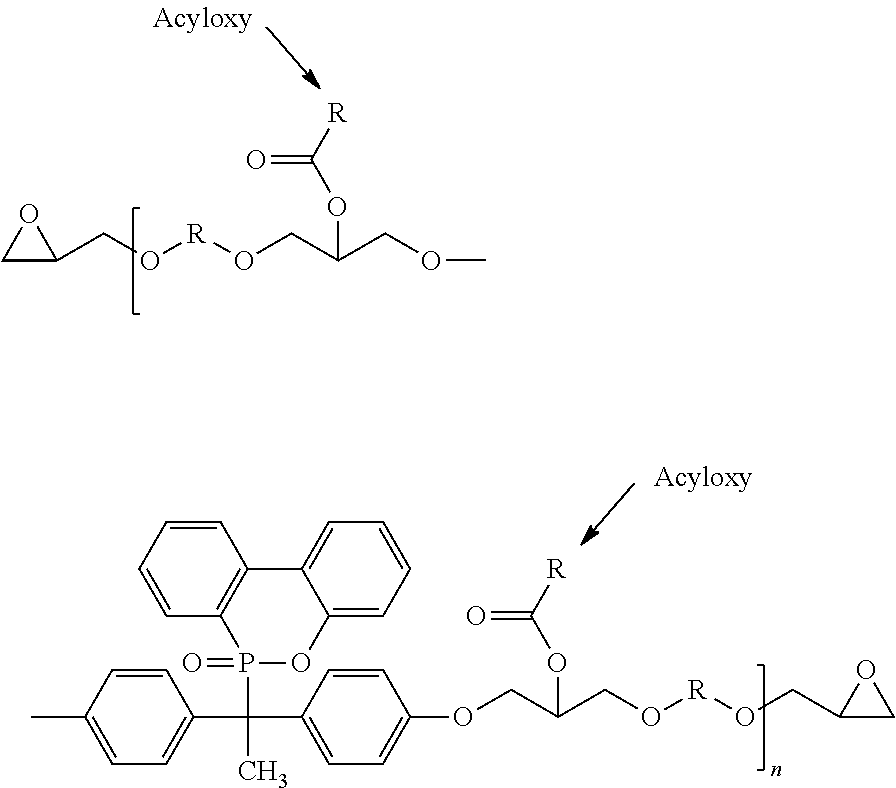Phosphorous containing compounds and process for synthesis
a technology of phosphorus and compounds, applied in the field of phosphoruscontaining compounds and preparation methods thereof, can solve the problems of inferior dielectric properties, high water absorption and inferior dielectric properties, and and achieves less water absorption, high water absorption and inferior dielectric properties, and a large polarity in the molecule.
- Summary
- Abstract
- Description
- Claims
- Application Information
AI Technical Summary
Benefits of technology
Problems solved by technology
Method used
Image
Examples
example 1
Synthesis of Phosphorus Containing Bisphenol Compound A1 (DMP)
[0107]
[0108]10.81 g (0.05 mole) of 9,10-dihydro-9-oxa-10-phosphaphenanthrene-10-oxide (DOPO), 23.5 g (0.25 mole) of phenol, 6.81 g (0.05 mole) of 4′-Hydroxyacetophenone, and 0.432 g (4 wt % based on the weight of DOPO) of p-toluenesulfonic acid were mixed and stirred in a 250 ml three-necked flask reactor at room temperature in advance. The reactants were stirred constantly at 130.degree. C. for 24 hours to form a mixture, and then the temperature of the mixture was cooled down to the room temperature. The crude products separated out from the cooled mixture were washed by ethanol and then filtrated and dried to obtain a white powder. The white powder was the phosphorus-containing bisphenol, and the chemical structure of the phosphorus-containing bisphneol A1.
[0109]The yield of the foregoing phosphorus-containing bisphenol was 85%, and the melting point was 306° C. The measured value of the carbon, hydrogen, and oxygen el...
example 2
Synthesis of Phosphorus Containing Bisphenol Compound A2
[0110]
[0111]10.81 g (0.05 mole) of DOPO, 36 g (0.25 mole) of 2-naphthol, 6.81 g (0.05 mole) of 4′-Hydroxyacetophenone, and 0.432 g (4 wt % based on the Weight of DOPO) of p-toluene sulfonic acid were mixed and stirred in a 250 ml three-necked flask reactor at room temperature in advance. The reactants were stirred constantly at 130° C. for 24 hours to form a mixture, and then the temperature of the mixture was cooled down to the room temperature. The crude products separated out from the cooled mixture were washed by ethanol and then filtrated and dried to obtain a white powder. The white powder was the phosphorus-containing compound A2.
[0112]The yield of the foregoing phosphorus-containing bisphenol was 85%, and the melting point was 317° C. The measured value of the carbon, hydrogen, and oxygen element were 75.54%, 4.58%, and 13.56%, respectively (the theoretical value, C, 75.31%; H, 4.85%; O, 13.38%.) by element analysis.
example 3
Synthesis of Phosphorus Containing Bisphenol A3
[0113]
[0114]10.81 g (0.05 mole) of DOPO, 36 g (0.25 mole) of 2-naphthol, 9.01 g (0.05 mole) of 6-acetyl-2-naphthol, and 0.432 g (4 wt % based on the Weight of DOPO) of p-toluene sulfonic acid were mixed and stirred in a 250 ml three-necked flask reactor at room temperature in advance. The reactants were stirred constantly at 130° C. for 24 hours to form a mixture, and then the temperature of the mixture was cooled down to the room temperature. The crude products separated out from the cooled mixture were washed by ethanol and then filtrated and dried to obtain a white powder. The white powder was the phosphorus-containing compound A3.
[0115]The yield of the foregoing phosphorus-containing bisphenol was 80%, and the melting point was 338° C. The measured value of the carbon, hydrogen, and oxygen element were 77.69%, 4.17%, and 12.25%, respectively (the theoretical value, C, 77.26%; H, 4.76%; O, 12.11%.) by element analysis.
PUM
| Property | Measurement | Unit |
|---|---|---|
| temperature | aaaaa | aaaaa |
| temperature | aaaaa | aaaaa |
| temperature | aaaaa | aaaaa |
Abstract
Description
Claims
Application Information
 Login to View More
Login to View More - R&D
- Intellectual Property
- Life Sciences
- Materials
- Tech Scout
- Unparalleled Data Quality
- Higher Quality Content
- 60% Fewer Hallucinations
Browse by: Latest US Patents, China's latest patents, Technical Efficacy Thesaurus, Application Domain, Technology Topic, Popular Technical Reports.
© 2025 PatSnap. All rights reserved.Legal|Privacy policy|Modern Slavery Act Transparency Statement|Sitemap|About US| Contact US: help@patsnap.com



